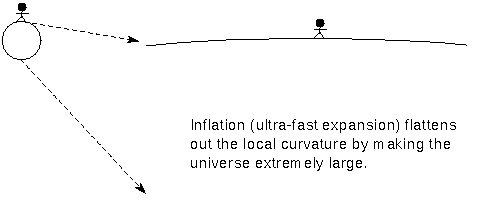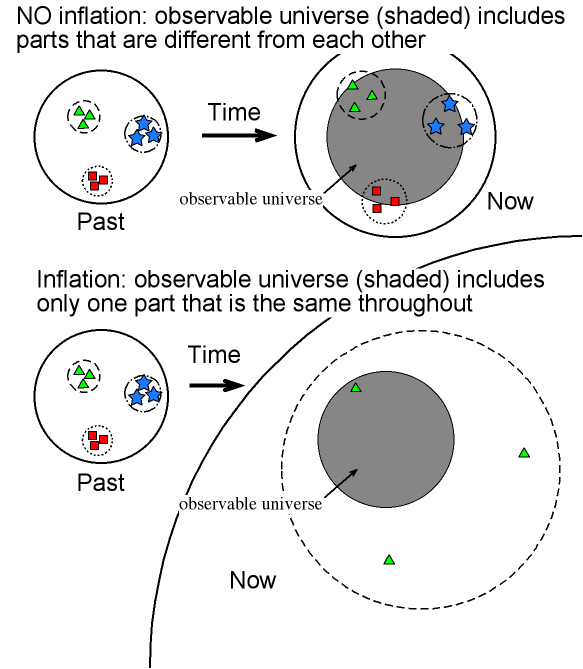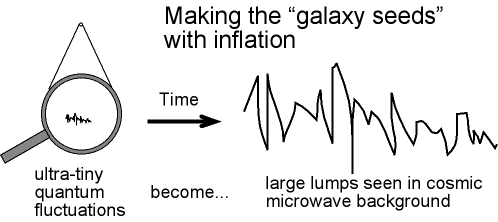
This material (including images) is copyrighted!. See my copyright notice for fair use practices.
There are a couple of problems with the standard Big Bang model. The first is called the flatness problem---why is the universe density so nearly at the critical density or put another way, why is the universe so flat? Currently, the universe is so well-balanced between the positively-curved closed universe and the negatively-curved open universe that astronomers have a hard time figuring out which model to choose. Of all the possibilities from very positively-curved (very high density) to very negatively-curved (very low density), the current nearly flat condition is definitely a special case. The balance would need to have been even finer nearer the time of the Big Bang because any deviation from perfect balance gets magnified over time. For example, if the universe density was slightly greater than the critical density a billion years after the Big Bang, the universe would have re-collapsed by now.
Consider the analogy of the difficulty of shooting an arrow at a small target from a distance away. If your angle of shooting is a little off, the arrow misses the target. The permitted range of deviation from the true direction gets narrower and narrower as you move farther and farther away from the target. The earlier in time the universe's curvature became fixed, the more finely tuned the density must have been to make the universe's current density be so near the critical density. If the curvature of the universe was just a few percent off from perfect flatness within a few seconds after the Big Bang, the universe would have either re-collapsed before fusion ever began or the universe would expanded so much that it would seem to be devoid of matter. It appears that the density/curvature was very finely tuned.
The second problem with the standard Big Bang model is the horizon problem---why does the universe, particularly the microwave background, look the same in all directions? The only way for two regions to have the same conditions (e.g., temperature), is that they are close enough to each other for information to be exchanged between them so that they can equilibrate to a common state. The fastest speed that information can travel is the speed of light. If two regions are far enough apart that light has not had enough time to travel between the regions, the regions are isolated from each other. The regions are said to be beyond their horizons because the regions cannot be in contact with each other (recall the term event horizon in the discussion about black holes).
The photons from the microwave background have been traveling nearly the age of the universe to reach us right now. Those photons have certainly not had the time to travel across the entire universe to the regions in the opposite direction from which they came. Yet when astronomers look in the opposite directions, they see that the microwave background looks the same to very high precision. How can the regions be so precisely the same if they are beyond each other's horizons? Running the expansion backward, astronomers find that regions even a degree apart in angular separation on our sky would have been beyond each other's horizons at the time the microwave background was produced.

The inflation theory predicts that the ultra-fast inflation would have expanded away any large-scale curvature of the part of the universe we can detect. It is analogous to taking a small globe and expanding it to the size of the Earth. The globe is still curved but the local piece you would see would appear to be fairly flat. The small universe inflated by a large amount and the part of the universe you can observe appears to be nearly flat. That solves the flatness problem.

The horizon problem is solved by inflation because regions that appear to be isolated from each other were in contact with each other before the inflation period. They came into equilibrium before inflation expanded them far away from each other. Another bonus is that the GUTs that predict inflation also predict an asymmetry between matter and antimatter, so that there should be an excess of matter over antimatter.
The inflation theory might also explain where the ripples in the microwave background (the "galaxy seeds") come from. Recall in an earlier section about the very early universe that matter-antimatter can change to energy and energy can change back to matter-antimatter. The laws of physics that deal with the very small scales of atoms, sub-atomic particles, etc. (quantum mechanics) predict that the matter-energy fluctuations should be going on even today at every point in space. It turns out that these quantum fluctuations can occur if they happen quickly enough to not be noticed (the greater the energy-matter fluctuation, the quicker the fluctuation must occur). Therefore, even in perfectly empty space (complete vacuum), there is a seething froth of fluctuations at very tiny scales, a vacuum energy---matter-antimatter virtual particles spontaneously appearing and then annihilating each other too quickly for us to detect. Although virtual particles-quantum foam might seem a bit too fanciful (to put it kindly), these virtual particles do produce measurable effects such as:

Now back to inflation. The quantum fluctuations in the very early universe could have been the galaxy seeds, but they would have been much too small to be the ripples we see in the cosmic microwave background. Before inflation that is! The super-rapid growth of the universe during inflation would have stretched the fluctuations to much larger sizes---large enough to create the ripples in the microwave background that eventually became enhanced to form galaxies under the action of gravity over billions of years. Although the current versions of inflation theory cannot answer all of the questions about the large-scale structures of our universe, they do predict a particular distribution of the ripple sizes in the microwave background that is consistent with the results from the high-altitude balloon experiments, the WMAP mission, and the Planck mission. The distribution of the ripples peaks at an angular size of one degree on the sky and the temperature varies by about 1 part in 100,000 as predicted by inflation. As astronomers continue to analyze data from the Planck spacecraft, they will be looking at how the microwave background photons scattered off the electrons just before the universe became transparent. Scattering causes light to become preferentially oriented in a particular way (it is "polarized"). The simplest version of inflation predicts a particular polarization of the microwave background that appears to be seen in the WMAP data. WMAP and Planck scientists will look for the imprint of gravitational waves from inflation which would provide much stronger evidence for the inflation theory.
A much-heralded discovery in March 2014 by the Background Imaging of Cosmic Extragalactic Polarization 2 (BICEP2) experiment at the South Pole of gravitational wave signatures in the microwave background turned out to be the result of an older incorrect model of the microwave emission from the interstellar dust in our galaxy that contaminates the cosmic microwave background. The BICEP2 team released its findings early so the observations could be checked by other research teams, including several others operating at the South Pole and the high elevation of the Atacama Desert in South America. Both places have cold, dry air that is very stable. The Planck team and the BICEP2 team then collaborated together to produce the most accurate model of what signals from the ancient gravitational waves should look like and showed in January 2015 that the earlier announcement was incorrect. The search for the gravitational waves imprint on the microwave background continues!
History of the universe from the Big Bang to the present day
Recent observations are indicating that the cosmological constant should be brought back. Astronomers are finding that even when they include the maximum amount of dark matter allowed by the observations, there is not enough matter (luminous or dark) to flatten the universe---the universe is open with negative curvature if the cosmological constant is zero. The inflation theory predicts that the universe should be flat to very high precision. An extra energy called called dark energy is needed to make the universe curvature flat overall beyond what ordinary and dark matter can do. This dark energy is probably the cosmological constant (vacuum energy) described above. Recent observations of the cosmic microwave background show that the combined efforts of matter and dark energy flatten space as much as that predicted by inflation theory.
One major stumbling block in the theory of the cosmological constant is that quantum theory predicts that the total vacuum energy should be on the order of 10120 times larger than what is observed. The cosmological constant predicted from quantum theory would cause the universe to expand so fast that you would not be able to see your hand in front of your face because the light would not be able to reach your eyes! In reality we can see to billions of light years. Physicists are trying to figure out why there is such a big discrepancy between the quantum theory's prediction and observation. Some cosmologists are exploring the idea of a dark energy that varies with space and time called "quintessence". Stay tuned for developments!
A crucial set of observations of very distant ("high-Z") Type Ia supernovae by two independent teams showed that the expansion rate is slower than expected from a flat universe. Type Ia supernovae are very luminous and can be used as standard candles to measure very large distances because they form from the collapse of a stellar core of a particular mass (1.4 solar masses). By measuring very large distances, astronomers can determine the geometry of the universe. The supernovae were fainter than expected. After exploring ordinary possibilities like intergalactic dust, gravitational lensing effects, and metallicity effects, the two teams were forced to conclude that either the universe has negative curvature (is open) or that the supernovae are farther away than the Hubble Law says they are—their redshifts are "too small" because the universe expanded more slowly in the past than expected. What was surprising about the supernova observations was that they showed that the expansion is accelerating! This surprising result would have been discounted at the start if it was found by just one team of astronomers. The fact that two independent, highly-competitive teams (eager to prove the other team wrong) found the same surprising result that was the opposite of their expectations meant that the accelerating universe conclusion could not be discounted. The two teams eventually got the Nobel Prize in Physics (in 2011) for their discovery. Since then other teams have confirmed that the universe's expansion has been accelerating for the past several billion years.
Accelerating expansion is impossible without a repulsive cosmological constant to overcome the slowing down effect of gravity. An accelerating universe will increase the derived age of the universe because the expansion rate long ago was slower than the expansion rate is now. The galaxies needed more time to get to their large distances than the original decelerating universe model said. Long ago gravity was the dominant force affecting the universe's expansion since everything was closer together. As the universe expanded the effect of gravity got diluted. Eventually, the strength of gravity dropped below the amount of the dark energy. Recent observations of how the expansion rate has changed over the history of the universe show that the dark energy began to dominate over gravity about 4 billion to 6 billion years ago but its presence began to be felt up to about 9 billion years ago.
The far future of the universe depends on the form that dark energy takes. If the dark energy is the cosmological constant, then the expansion of the universe will continue long after all of the stars have died out many trillions of years in the future. If the dark energy is one of the possible forms of "quintessence", the acceleration rate increases and the galaxies, stars, even atoms are torn apart in a "big rip" on a time scale before all of the stars die out (but after our Sun dies). Other forms of the dark energy could cause the universe to re-collapse after its current period of acceleration.
Detailed studies of the microwave background and further observations of supernovae with better detectors such as the Dark Energy Survey and new larger space telescopes in the future will tell us if the dark energy is a cosmological constant or a quintessence form. Results from the WMAP and Planck missions and refined measurements of Hubble Constant with the Hubble Space Telescope lean toward the cosmological constant form. However, we have learned enough from the past few years of surprising observations to say that Einstein's greatest blunder was saying that he made a blunder!
The Planck data has created a significant tension with measurements of the Hubble Constant. The Hubble Constant found from careful measurement of the distance scale ladder finds the Hubble Constant to be 73.5 +/- 1.6 km/sec/Mpc. The Planck derivation from measurements of the cosmic microwave background radiation is just 67.4 +/- 0.5 km/sec/Mpc. The eBOSS mapping of distant galaxies points to the lower number. Although they are close to each other, the 6.1 km/sec/Mpc difference is much larger than the uncertainties. That might be telling us of unexpected complexities in the dark energy or some new exotic particle (besides whatever is the dark matter) that needs to be added to the standard model of cosmology and particle physics or there's some peculiarity in our part of the universe that affects the expansion rate in a way we haven't accounted for. Unfortunately, changes to the standard model would throw off the excellent fit of the standard model to other features of the microwave background. The discrepancy will be resolved in the typical way of science: cross-checking of the analyses, gathering more data, and creative modifications to our understanding of the underlying physics.
The light we see from distant objects has been stretched by the expansion of space and while the light has been traveling the space between the distant object and us, the space itself has been stretching, so how far away is that object from us now? It depends on what values of the Hubble Constant, Omega matter, and cosmological constant you use. See Ned Wright's Cosmology Calculator to find out the distance to that distant object and learn about the various ways of talking about the distance in an expanding universe: "comoving radial distance", "angular size distance", and "luminosity distance". A simulation showing how the separation distance between galaxies increases while the light travels is the AstroSims Cosmological Redshift Simulator. It uses a simplified version of the expansion with the Hubble Constant as the only variable.
| cosmological constant | dark energy | inflation |
|---|
last updated: June 28, 2022